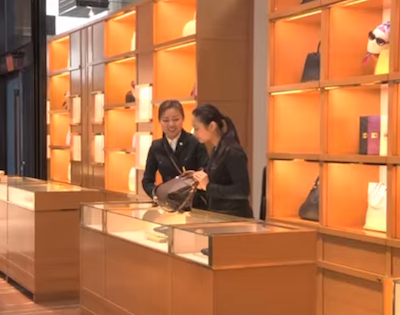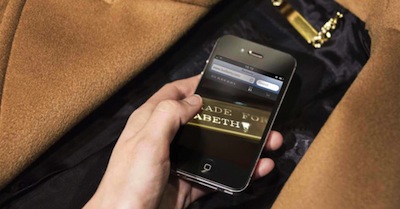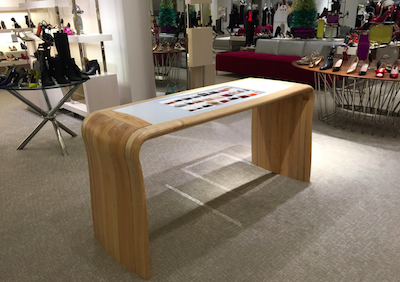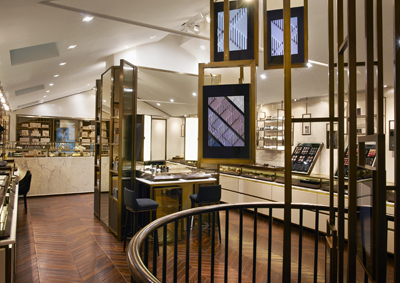 Instagram post from Manolo Blahnik
Instagram post from Manolo Blahnik
Despite many industry insiders predicting that bricks-and-mortar will be phased out, 90 percent of retail sales transactions still occur in-store, according to a new report by Boston Retail Partners. Boston Retail Partners’ “The Future Store Manifesto” focuses on how future retail will be an “omnichannel theatre blending the physical sensory experience with the convenience of digital,” a strategy that is slowly being implemented by retailers across industry sectors. As consumer expectations have shifted toward increased mobile interaction, retailers have been faced with challenges, and necessary adaptations are needed to deliver the experience expected in-stores.
“The number one key to retail success in the future store is to personalize the shopping experience with customer context – bringing the 'Amazon experience' to the store,” said Ken Morris, principal at Boston Retail Partners. “Customer context – the interrelated factors of customer insights and environmental conditions that make the shopping experience relevant – is essential to personalizing the experience.
"Successful retailers will infuse digital features into the store environment to exceed customer expectations, compete more effectively with online pure-play retailers and offer a truly unique, sensory and personalized shopping experience,” he said. “Over the past 20 years, many in the retail industry have predicted the demise of the physical store.
"However, 90 percent of all retail sales transactions still occur in the store and, according to McKinsey & Company, e-commerce only accounts for 4 percent of luxury retail sales."
Rising from the ashes As consumers have become more accustomed to online features such as product reviews, extensive inventories, one-click transactions and personalized recommendations, the in-store experience has become limited. But, through in-store digitalization, retailers have an opportunity to bridge what is done online within the walls of physical storefronts to offer a complete experience. "The reality is, the store is still the foundation of retailing and many shoppers enjoy the theatre of shopping," Mr. Morris said. "To secure the future of the physical store, retailers will need to focus on the in-store benefits – it is where the tactile and sensory experience comes together for the consumer. "Online shopping only incorporates two senses – sight and sound, whereas a physical store infuses all fives senses – sight, sound, touch, smell and taste," he said. "If you can appeal to all five senses, you have a better chance of inspiring consumers to complete the purchase.” Sales associate with a consumer at Louis Vuitton
The Future Store Manifesto suggests that by focusing on holistic experiences rather than channel integration retailers will be better able to transform with changing consumer expectations. To do so, BRP says that retailers must evolve to include multichannel and omnichannel retailing to offer consumers seamless in-store experiences in-store, online and on mobile devices.
Furthermore there are five elements necessary to establish the future store. BRP lists these “musts” as mobile, relevant, personal, ubiquitous and secure.
While mobile is now seen as a given, the channel still provides retailers with an opportunity to enhance customer service beyond the point of sale. Placing mobile devices on the sales floor frees associates from behind the counter, thus enabling personalized interactions and simplifying the purchase path.
Also, mobile technology will play a larger role in personalization through the use of sensors or beacons that will identify consumers via their device when they enter the store. Sales associates then can allocate the information provided to curate a one-on-one experience per consumer.
Sales associate with a consumer at Louis Vuitton
The Future Store Manifesto suggests that by focusing on holistic experiences rather than channel integration retailers will be better able to transform with changing consumer expectations. To do so, BRP says that retailers must evolve to include multichannel and omnichannel retailing to offer consumers seamless in-store experiences in-store, online and on mobile devices.
Furthermore there are five elements necessary to establish the future store. BRP lists these “musts” as mobile, relevant, personal, ubiquitous and secure.
While mobile is now seen as a given, the channel still provides retailers with an opportunity to enhance customer service beyond the point of sale. Placing mobile devices on the sales floor frees associates from behind the counter, thus enabling personalized interactions and simplifying the purchase path.
Also, mobile technology will play a larger role in personalization through the use of sensors or beacons that will identify consumers via their device when they enter the store. Sales associates then can allocate the information provided to curate a one-on-one experience per consumer.
 Photo courtesy of Burberry
To that effect, being relevant is an important touchpoint in the future store and can be achieved through geolocation and geofencing that will target consumers at the right time and place through contextual messages.
Relevant technology such as touch screens, smart fitting rooms, virtual mirrors and virtual reality also play an important role to create an immersive environment. Along with a sales associate these technologies can provide customer information, purchase history and current in-store promotions.
Building on the aforementioned strategies, creating a personal experience for consumers is key to the future store.
For personalization, mobile will become increasingly vital by acting as an agent for clienteling, guided selling, inventory checks and checkout. More so, interactions via mobile can include at home video chatting with preferred sales associates to gain a better understanding of products.
Photo courtesy of Burberry
To that effect, being relevant is an important touchpoint in the future store and can be achieved through geolocation and geofencing that will target consumers at the right time and place through contextual messages.
Relevant technology such as touch screens, smart fitting rooms, virtual mirrors and virtual reality also play an important role to create an immersive environment. Along with a sales associate these technologies can provide customer information, purchase history and current in-store promotions.
Building on the aforementioned strategies, creating a personal experience for consumers is key to the future store.
For personalization, mobile will become increasingly vital by acting as an agent for clienteling, guided selling, inventory checks and checkout. More so, interactions via mobile can include at home video chatting with preferred sales associates to gain a better understanding of products.
 Interactive retail table top at Nieman Marcus (see story)
BRP also suggests that retailers adapting a future store model must be ubiquitous, meaning that real-time retail must deliver seamless, personalized experiences whenever, wherever and however the consumer wishes to shop. For retailers this means product, pricing and inventory data and consumer information must be accessible across all channels, instantly.
To do so, BRP notes the use of cloud commerce to provide real-time data to limit the risk of a retailer appearing out-of-date, inaccurate or out of context. Cloud commerce also provides retailers with a single, unified platform that enables brands to deliver consistency and relevant experiences in an omnichannel environment.
Since the future store culls consumer information, retailers need to balance gathering data from shoppers and maintaining a level of trust as to avoid fears of data theft and fraud. This can be accomplished through security measures that emphasize privacy while still curating personalized experiences without the personal risk of a data breach.
Additionally, there are a number of micro trends that fit into the great scheme of the future store. These trends include online pure-players entering physical retail; showrooming that connects the in-store displays to mobile; stores as theaters where “entertainment” is offered for an emotional connection; stores as distribution centers to optimize inventory and pop-up shops to extend a brand without long-term costs and complexity.
By implementing these five elements for the in-store model, retailers will transform the physical retail experience for the foreseeable future.
Mr. Morris cites British apparel and accessories brand Burberry as an example of a label that has integrated digital well into its physical stores.
Interactive retail table top at Nieman Marcus (see story)
BRP also suggests that retailers adapting a future store model must be ubiquitous, meaning that real-time retail must deliver seamless, personalized experiences whenever, wherever and however the consumer wishes to shop. For retailers this means product, pricing and inventory data and consumer information must be accessible across all channels, instantly.
To do so, BRP notes the use of cloud commerce to provide real-time data to limit the risk of a retailer appearing out-of-date, inaccurate or out of context. Cloud commerce also provides retailers with a single, unified platform that enables brands to deliver consistency and relevant experiences in an omnichannel environment.
Since the future store culls consumer information, retailers need to balance gathering data from shoppers and maintaining a level of trust as to avoid fears of data theft and fraud. This can be accomplished through security measures that emphasize privacy while still curating personalized experiences without the personal risk of a data breach.
Additionally, there are a number of micro trends that fit into the great scheme of the future store. These trends include online pure-players entering physical retail; showrooming that connects the in-store displays to mobile; stores as theaters where “entertainment” is offered for an emotional connection; stores as distribution centers to optimize inventory and pop-up shops to extend a brand without long-term costs and complexity.
By implementing these five elements for the in-store model, retailers will transform the physical retail experience for the foreseeable future.
Mr. Morris cites British apparel and accessories brand Burberry as an example of a label that has integrated digital well into its physical stores.
 Burberry's connected beauty store in Covent Garden, London
"Burberry stands out as one of the most innovative luxury retailers from a future store perspective,” Mr. Morris said. “Burberry’s Regent Street store in London features a digital interactive environment to enrich the shopping experience with a truly theatrical atmosphere.
"Store associates also tailor the shopping experience with iPad applications that provide purchase history and customer preferences," he said.
Retail gets real
Bricks-and-mortar remains as the central hub of the shopping journey, but its role is certainly changing.
Retailers must adapt to changing consumer preferences by adopting real-time retail strategies that deliver a more personalized shopping experience, according to a special report by Boston Retail Partners.
Real-time strategies that use the latest technology to target the consumer and appeal to her unique taste will help retailers be more successful. Ultimately, the goal of these real-time strategies should be to establish an enjoyable multichannel experience for consumers accustomed to online and mobile environments (see story).
This is not to say that ecommerce should be neglected, as it is an integral part of retailing today.
Eighty-five percent of retailers anticipate a growth in their ecommerce sales next year, according to a new report from Boston Retail Partners.
Along with the rise in digital purchases, connected consumers have been given more power, as they drive retailers to adopt updated technology to better serve them. At the top of consumers’ list of expectations is a seamless experience across channels, or unified commerce, a step above omnichannel that enables a personalized experience regardless of how the consumers chooses to connect along their purchase path (see story).
Burberry's connected beauty store in Covent Garden, London
"Burberry stands out as one of the most innovative luxury retailers from a future store perspective,” Mr. Morris said. “Burberry’s Regent Street store in London features a digital interactive environment to enrich the shopping experience with a truly theatrical atmosphere.
"Store associates also tailor the shopping experience with iPad applications that provide purchase history and customer preferences," he said.
Retail gets real
Bricks-and-mortar remains as the central hub of the shopping journey, but its role is certainly changing.
Retailers must adapt to changing consumer preferences by adopting real-time retail strategies that deliver a more personalized shopping experience, according to a special report by Boston Retail Partners.
Real-time strategies that use the latest technology to target the consumer and appeal to her unique taste will help retailers be more successful. Ultimately, the goal of these real-time strategies should be to establish an enjoyable multichannel experience for consumers accustomed to online and mobile environments (see story).
This is not to say that ecommerce should be neglected, as it is an integral part of retailing today.
Eighty-five percent of retailers anticipate a growth in their ecommerce sales next year, according to a new report from Boston Retail Partners.
Along with the rise in digital purchases, connected consumers have been given more power, as they drive retailers to adopt updated technology to better serve them. At the top of consumers’ list of expectations is a seamless experience across channels, or unified commerce, a step above omnichannel that enables a personalized experience regardless of how the consumers chooses to connect along their purchase path (see story).
"There is no denying that the store is on a cusp of a significant transformation and retailers need to focus on their long-term strategy to keep their stores relevant to consumers,” Mr. Morris said. “The banking industry leveraged the networks in the '80s and '90s to install ATMs and completely changed the consumer banking experience.
"There is a huge opportunity for retailers to leverage the network and mobile devices to engage with consumers in a new way – changing retail forever," he said.
Final Take Jen King, lead reporter on Luxury Daily, New York